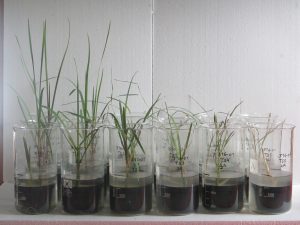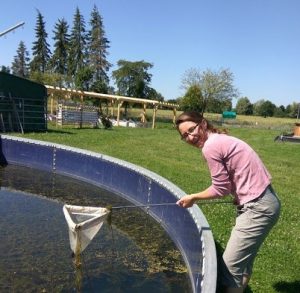The Applied Module at External Organizations (AMEO) is an 8-week internship taking place during the 2nd semester of the MSc Ecotoxicology program. Teresa and Harshada completed their AMEO at Mesocosm GmbH, a company that is specialized in higher-tier and non-standard tests. In this post, they report on their experience in conducting a macrophyte ring test.

Ring test with the macrophyte Glyceria maxima; Control vessels are on the left and treatments with increasing concentrations of the reference substance are on the right (photo by T. Fagundes)
At Mesocosm GmbH, our project was to conduct a ring test, which basically consisted of testing new procedures that will soon, with the necessary adjustments, constitute a standardized test for a specific model species. Our model species, or in a more exact terminology, our model system, was the macrophyte Glyceria maxima.
There is a need to develop this test due to the fact that despite the battery of plant tests used nowadays, there still is no test available to address effects on emerging monocotyledon macrophytes, with uptake through the roots. This is the gap that the Organisation for Economic Co-operation and Development (OECD) is trying to fill by developing this standard test. Several laboratories from different countries run a draft of the test procedures which has been designed by a specialized international working group. The results of the tests and the comments from all these labs are then returned to the OECD working group which evaluates the feasibility, sensitivity and reproducibility of the draft test and designs a final testing guideline.
Our tasks covered all the steps for execution of the test, from selecting and acclimatizing the plants to setting up the lab, measuring the environmental conditions and assessing endpoints. Dealing with a non-standard species sometimes brings some contingencies along, but we managed to overcome them. Besides our participation in the ring test, we were involved in many other tasks, such as outdoor testing and housing of other aquatic plant species in mesocosms, and tests with snails and copepods.
I have to emphasize that we were extremely well received, in a familiar atmosphere that resembled that of an academic environment, with the only difference that we were the only “Internationals”. And despite not speaking German, we were quickly integrated in the team. The friendly relationships and the collaborative spirit went beyond the limits of the company and extended to other contract research organizations. Having specific niches of activities, these companies work together in many projects, and therefore we had the opportunity to take part in other field and semi-field studies focusing on mammals.
Toward the end of our AMEO we attended an Ecotoxicology course organized by those collaborating companies and partner universities. This course culminated, on the last day of our internship, with a visit to the Frauenhofer Institute in Schmallenberg, which we much appreciated.
I think it is fair to say that our AMEO achieved all its goals and surpassed expectations! During these weeks, we both got a real world experience and a chance to apply what we had learned in the previous semester of the master program, as well as the opportunity to get to know the professional world of ecotoxicology, extend our network and, last but not least, see how we like the daily tasks involved in the job.

